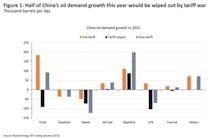WoodMac: US oil tariffs on Canada, Mexico would impact North American crude flows
US oil tariffs enacted by the Trump administration on Canada and Mexico would lead to a ‘significant shift in crude flows in North America,’ as higher prices push a portion of US imports into overseas markets, Wood Mackenzie said in a recent report.
The proposed US tariffs of 10% and 25% on Canadian and Mexican oil products, respectively, would alter crude flows for all three countries. Higher ensuing prices would ultimately affect demand in the US, although the impact is expected to be softer than a more disruptive 25% tariff on Canadian oil, according to the report.
“A wide range of scenarios are still at play, as the implementation of tariffs has been delayed by a month,” said Dylan White, principal analyst, North American Crude Markets, Wood Mackenzie. “The uncertainty surrounding US policy is likely to continue; ongoing talks could lead to a lifting of tariffs or could spiral into steeper penalties on oil imports. As the tariffs currently stand, the North American market will see several impacts.”
Tarriff impacts on Mexico
In a scenario where a 25% tariff is imposed on Mexican oil, Wood Mackenzie forecasts that Mexican exports are likely to redirect from the US to alternative markets in Europe and Asia. This shift could affect about 600,000 b/d of oil imports from Mexico into the US. However, the potential impact might be alleviated by the closure of the Lyondell Houston refinery and the commissioning of Pemex's Dos Bocas refinery, the report noted.
“Backfill options for heavy barrels in the US crude slate, especially in the US West Coast and US Gulf Coast, would need to come from waterborne imports via Latin American and Middle East countries,” said White. “Iraq, in particular, flexes the largest alternate pool of heavy crude exports. However, these imports are generally cost disadvantaged compared to nearby Canadian and Mexican heavy supply.”
If a 10% tariff scenario arises for Mexico, Wood Mackenzie expects the impact on shipments to the US would be less severe, although regional prices would still be affected to some degree.
“Steeper tariffs on Mexico would likely shift Mayan imports away from the US, with subsequently tighter heavy balances leading to slightly higher relative heavy prices in the US Gulf Coast,” said White. “Beyond that, we expect the higher tariff costs will get backed into wider crude differentials in Mexico and Canada.”
Tariff impacts on Canada
In a scenario where a 10% tariff is imposed on Canadian oil, Wood Mackenzie anticipates that Canadian crude will predominantly remain in use in the US midcontinent and the US Gulf Coast.
“Refineries in the Midcon are landlocked and have limited access to alternate sources of heavy crude and are therefore dependent on Canadian supply,” said White. “However, Canadian outlets to non-US destinations become advantaged. The Trans Mountain Pipeline (including TMX) provides access to the Pacific Basin and would likely facilitate increased shipments of Canadian crude to Asia, and away from the US West Coast, in a tariff scenario.”
Re-exports of Canadian crude via the US are not subject to tariffs and would provide optionality to Canadian barrels transiting the US. However, Wood Mackenzie does not expect a 10% tariff would be substantial enough to shift Canadian barrels away from the US Gulf Coast and into Asia.
Tariff impacts on the US
Wood Mackenzie projects that the tariffs would drive oil demand 50,000 b/d lower in the US by 2026, in part due to modestly higher refined product prices.
Relief from domestic producers is unlikely, as Wood Mackenzie continues to forecast moderate US Lower 48 production growth in the years to come, driven by majors in the Permian basin.
Producers remain cash disciplined; drilling investment in recent years has shown little reactivity to changes in crude prices.


